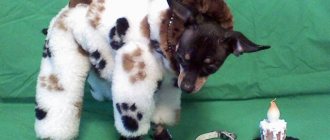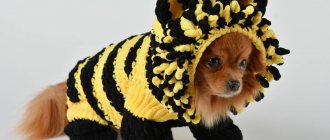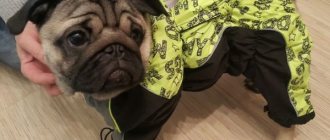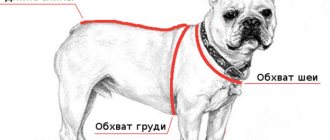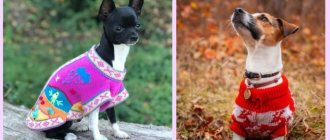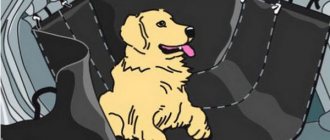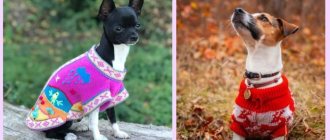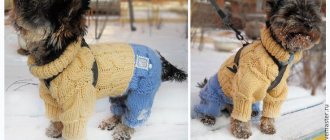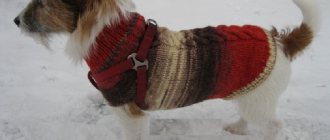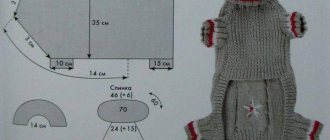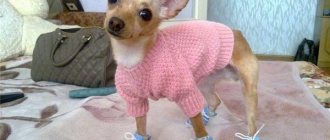DIY knitted clothes for toy terriers.
For craftswomen who delight their household with their knitted products, you can skip the preparatory stages (they already know everything). But for those who want to try to create clothes for a pet with their own hands, you should prepare by carefully studying and following our tips on knitting/crocheting for a toy terrier.
Knitting for toy terrier.
Dedicated to needlewomen who confidently hold knitting needles and hooks in their hands.
You can create a unique wardrobe for your pet by creating a range of knitted clothes for your toy terrier with your own hands. Knitted clothes differ favorably from sewn and purchased ones in that, firstly, they are very warm, and secondly, they are ideal for freezing small dogs that lack protection in the form of a thick undercoat.
Benefits of knitted clothes.
In addition to the above properties of clothing made from yarn, it is worth highlighting the differences between the following things:
- practicality, versatility.
- aesthetics.
- uniqueness.
- Possibility of application in many situations.
Types of yarn for knitting.
Considering the tendency of toys to exhibit allergic reactions, you should be especially careful when choosing yarn. Your pet needs to knit things from natural yarn:
- cotton and linen. Eco-friendly, grown without pesticides, and dyed using natural dyes, cotton and linen yarns are durable and dry quickly after absorbing moisture. If you are thinking about how to knit a sweater for a toy terrier for walks in spring and autumn, then cotton or linen threads will do just fine.
- silk (natural or artificial). Summer versions of dog clothes made of natural silk will allow the dog to dress up on the street, but the skin will breathe and will not overheat. Artificial silk in its pure form is not used to create a new item, but is added to cotton or linen.
- wool A woolen sweater, jacket or overalls will be appropriate in winter, since wool is characterized by elasticity and lightness. Comfort for the pet is ensured by adding plant or artificial fiber to the product.
- angora wool. Products made from Angora wool in its pure form are not suitable for toy terriers. When knitting, be sure to add a thread of merino wool or acrylic fiber.
- merino wool. Yarn is very expensive, so a pure merino wool product can cost you a pretty penny. To make a toy item cheaper, look for yarn that contains another fiber. But even despite the presence of various additional threads in merino wool, today, clothes made from such yarn are the warmest and most practical for toy terriers.
- camel hair. To make your pet comfortable in things made from this type of wool, take soft yarn.
- mohair. Beautiful yarn of various colors will allow you to intelligently combine and create unique products. And the fluffiness of mohair gives things an extra zest.
- cashmere If you are a fan of this yarn, keep in mind that cashmere is not suitable for knitting dog clothes because it is not wear-resistant and washable.
- viscose. By combining viscose with cotton or linen thread, you can knit a lot of things for your beloved dog.
- fancy yarn (boucle, ribbon thread, etc.) is used to create stylish little things.
What can you knit for a toy terrier?
You can knit this terrier from threads of yarn:
- blanket.
- sleeveless vest/vest.
- sweater, jacket.
- overalls.
- Italian greyhound.
- booties for the home.
- hats and caps.
DIY knitted clothes for toy terriers.
For craftswomen who delight their household with their knitted products, you can skip the preparatory stages (they already know everything). But for those who want to try to create clothes for a pet with their own hands, you should prepare by carefully studying and following our tips on knitting/crocheting for a toy terrier.
Taking measurements for knitted clothes.
We arm ourselves with a measuring tape, pen and paper to write down the measurements taken.
- We call the toy terrier to us and give the command “Sit!”
- measure the circumference of the neck. If your pet dodges you, then to take this measurement, you can measure the collar.
- The following measurements are taken while the dog is standing.
- The length of the desired product is measured from the place where the collar is on the dog to the tail. If you want the dog's butt to be visible from under the thing, then the distance will be less.
- behind the front paws we measure the circumference of the chest.
- The length of the sleeve is measured according to the dog’s leg, and then adjusted during the knitting process.
What kind of walking clothes should a dog wear?
- Convenient - otherwise the pet will refuse to go out altogether, and the owner will wonder what the real reason is. If there is pressure somewhere and restricts movement, he may boycott the process of dressing and the walk itself.
- Seasonal - intended for a certain time of year. If you dress a dog inappropriately for the weather, then just like a person, problems with heat regulation may arise. Overheating in winter overalls in cloudy autumn weather can cause you to get sick. To avoid these unpleasant situations, it is advisable to acquire several sets and dress according to the weather.
- High-quality - on street walks, a little fidget in the snow and rain will not always worry about the safety of even the most beautiful outfit. Frolic in dry grass, getting dirty in the mud, lying on a dusty lawn with your brothers - how can you refuse such pranks. Because of this, your clothes will have to be washed often, and they must withstand all these tests with dignity. Knitted items are best made from good thick yarn. You shouldn’t restrict your dog from such pleasant little things just because the outfit is expensive and beautiful and should be treasured.
To do this, dog breeders have the idea to create a jumpsuit or a practical outfit for their pet on their own. Let's look at some tips on how to create a knitted jumpsuit and the necessary autumn attributes.
Overalls for toy terrier
You will need:
Lilac yarn 50% acrylic, 50% wool – 100 g
A little white wool for finishing
5 needles No. 2 for circular knitting
Patterns:
Row 1: * purl 2, knit 2 *, purl 2. Repeat the fragment between the stars.
Row 2: * knit 2, purl 2 *, knit 2.
Row 3: * purl 2, knit 2 * (first knit the second knit stitch behind the back wall, then the first), purl 2.
Row 4: * knit 2, purl 2 * (first purl the second stitch, then the first), knit 2.
Row 5: Repeat the pattern starting from the third row.
Knit stitch: knit rows are knitted with knit stitches, purl rows with purl stitches.
Star pattern: knit 3 stitches together. Without removing them from the left knitting needle, yarn over and knit 3 knit stitches together again. Remove the stitches from the left needle.
1st row: remove 3 knit stitches onto an auxiliary needle and place before work, 3 knit stitches, 3 knit stitches from an auxiliary needle.
Row 2: leave knit 3 on the auxiliary needle while working, knit 3, knit 3 from the auxiliary needle.
Instructions
Divide the yarn into two parts. One ball is 1/3 of the skein, the second is 2/3.
Front and back
Start knitting overalls for a toy terrier by casting on 60 stitches. Knit the neck with an Italian rib. At a height of 5 cm, turn the fabric over and knit an elastic band on the wrong side. This is done so that the lapel has a pattern on the front side. Knit another 6 cm with an elastic band. In the last row, increase every two stitches. There should be 88 stitches on the knitting needles.
Further, the knitting pattern for overalls for a toy terrier suggests that work should be continued from two balls at the same time. From one ball, knit the front. It will require 30 loops. Work it in stockinette stitch. From the second - a back of 58 loops with the “Braid” and “Star” patterns, as shown in the photo: edge, 2 purl, 12 loops of the “Braid” pattern, 2 purl, 24 loops of the “Star” pattern, 2 purl, 12 loops of the “Star” pattern Braid”, purl 2, edge.
Having knitted 14 cm, close the loops of the front part. After another 12 cm, complete the back.
Sleeves and legs
Cast on 34 stitches for the sleeve on 4 needles. Do the work with a regular 1 x 1 elastic band. Finish the work at a height of 13 cm. Knit the second sleeve in the same way. The trouser legs are knitted similarly. Only their length is a little longer - 16 cm.
Assembly
This is the end of the story about how to knit a jumpsuit for a toy terrier with knitting needles. Sew the front and back side seams and sew in the legs and sleeves.
Using a crawfish crochet hook with white thread, tie around the neckline, lower back and front, and cuffs. In this case, the bottom of the back can be pulled down a little.
Knitting "crawfish step" is used to finish the edges of products. When performing this, each time insert the hook into the previous loop. The result will be a spectacular edge in the form of small dense waves. It will not only decorate the product, but also strengthen it, since during wear the edge thread most often breaks or frays.
Selection of yarn and knitting needles
Yarn and knitting needles are selected together. Depending on the model, you need to choose a knitting needle. If the raglan model is something you see very often, then you should definitely choose double needles. Regular knitting needles with eyes will serve as good friends for making classic patterns.
You need to carefully choose the yarn for your “favorite”; cheap and cold ones are not suitable.
A dog, like a child, requires warmth and affection. This is exactly what the yarn should be like. The yarn is selected for the cold season, and the more warm fibers it contains, the better.
How to knit a jumpsuit for a toy terrier with knitting needles
When knitting overalls for a Chinese Crested, Pinscher, Schnauzer or Chihuahua, take into account their lack of thick and long hair. The suit should fit snugly to the body, but not rub. To make a jumpsuit for a small Yorkie or Chihuahua, you will have to make a small supply, given the dog’s long hair. Clothes for large males are made using the same principle.
For a baby Toy Terrier or Chinese Crested, cast on 52 stitches and knit 12 rows with a regular 1x1 elastic band. After this, you need to knit 5 rows with a garter pattern of knit stitches and cast off 12 stitches on the armhole. For the back, 12 rows are knitted, and for the front part - 21. The previously closed 12 loops of the armholes are also added here and the fabric is closed in a circle. Next, knit 5-6 cm and close the next 12 loops on the stomach. After another 8 cm of knitted fabric, close the same number of loops on the back. The corners are made separately, closing 2 loops in rows until the end of knitting.
Sleeves for the front paws are made separately, casting on 30 stitches on toe knitting needles. They are placed on four needles, knitted in 4 cm garter stitch and finished. The legs for the back legs start from the corners of the main product, slightly short of the armhole on the stomach. Loops are gradually added to make a total of 40, and about 6 cm are knitted in the round. To shape the armhole, it is tied, catching loops through one. This way it will stretch slightly and the overalls will look better.
Sweater for toy terrier
You will need:
blue wool – 100 g
blue wool – 50 g
red and green yarn - 20 g each
Patterns:
Elastic band 1x1 (*knit 1 loop, purl 1*)
Knit stitch: knit rows are knitted with knit stitches, purl rows with purl stitches
Instructions:
Knitting a sweater for a toy terrier begins with calculating the stitches. The collar, sleeves, front and hem are made with elastic. The back and hood are in stockinette stitch with a patterned element.
Neck circumference with an increase of 70 loops for the lapel
Before – 24 loops
Back – 46 loops
The distance between the paws in the front is 36 loops
Distance from neck to front paws – 9 rows
When moving from the collar to the back, you need to add 15 loops, to the front 7 loops
Front leg circumference – 27 loops
Sleeve width – 30 loops
Armhole depth - 3 loops
Hood height (from the base of the crown to the neck) – 40 loops
Hood depth – ½ the distance along the back of the head from temple to temple + 6 cm for a loose fit – approximately 64 loops
Front and back
The story of how to knit a sweater for a toy terrier will begin with a set of loops. Cast on 70 stitches and knit an elastic band 7 cm high. Divide the knitting into two parts: 24 loops - front, 46 loops - back. Knit them from two different balls.
Front row 1: Yarn over every 3 stitches for a total of 7 times.
Back row 1: Yarn over 1 every 3 stitches. Total 15 times.
2nd row of front: knit 31 loops with an elastic band.
2nd row of back: 61 purl stitches.
Front row 3: slip 1 stitch, yarn over, knit 29 stitches with an elastic band, knit 1.
3rd row of back: slip 1 stitch, yarn over, knit 59 stitches, knit 1.
4th row of front: knit 33 loops with an elastic band.
4th row of back: 63 purl stitches.
Knit 4 more rows, placing a yarn over along the edges of the front row of each piece.
At the same time, start knitting the pattern from the 5th row.
Front row 9: cast off 3 stitches, knit 34 stitches with an elastic band.
Back row 9: cast off 3 stitches, knit 64 stitches.
Front row 10: bind off 3 stitches, 31 stitches with an elastic band.
10th row of back: bind off 3 loops, 61 loops and purl.
Now knit the toy terrier sweater in a straight line. At the end of the 19th and 20th rows of the front and back, cast on 3 air loops.
Knit the piece further until it reaches a length of 8.5 cm from the collar. Then knit 1.5 cm. elastic band at the front and close the loops. Continue knitting the back with a pattern, decreasing 1 loop in every second row along the edges (remove the edge loop, knit 2 loops together, knit according to the pattern, 2 loops together, edge stitch). When the back reaches 20 cm, close all the loops and fasten the ends of the colored threads on the wrong side.
Sleeves
What kind of sleeveless sweater for a toy terrier? For them, use blue thread to cast on 30 loops on the knitting needles and knit 4 cm with an elastic band. The sleeves are rectangles. Close the loops.
Assembly
Sew shoulder seams. Sew the sleeves into the armholes. Then sew the side seams of the sweater and sleeves. Cast on 108 stitches on the knitting needles and tie a strip about 1.5 cm wide with an elastic band. Sew it along the edge of the back. Secure the ends at the bottom of the front part.
Hood
Knit a fabric 12 cm high and 30 cm wide using stockinette stitch. Rub the first 1.5 cm with a blue thread. Continue working in stockinette stitch with blue wool. Fold the piece in half, sew one side closed, and then sew it to the collar of the Toy Terrier sweater. Decorate the top of the hood with a pompom.
Features of knitting a sweater for a dog on knitting needles
To create a sweater for a dog, you need to go through several steps:
Stage 1: taking measurements
When measuring, take into account that the “pet” will be active in the finished sweater and therefore immediately make adjustments of a few centimeters:
- product length (from collar to tail);
- width of the product (between the front and back paws);
- back and chest circumference;
- distance between paws;
- waist (abdomen) circumference;
- OL - paw circumference;
- ОШ - neck circumference.
How to take measurements from a dog
The peculiarity of a dog sweater is that the back is usually knitted wider and longer; especially for a dachshund, models need longer lengths. Let's walk through step by step for beginners how to properly knit a warm sweater for a dog with your own hands.
Knitting pattern for a sweater for a small dog
Important! All measurements presented should be taken when the dog is in a relaxed state.
Stage 2: gate
Based on the measurements, a set of loops is made and then the neck is knitted.
Where to start with a dog sweater
More often the collar is simply done with an elastic band.
Important! The neck for a dog is not made long so that it does not interfere with the “pet”.
Stage 3: Raglan
The length of the raglan will depend on your measurements, as will all the details of this product.
Stage 4: sleeves
Knitting a collar and raglan
The loops for the sleeve will be closer to each other on the side of the front piece.
Stage 5: back/front
After reaching the required length, you need to make an elastic band and close the loops.
How to knit a sweater for a toy terrier
The Toy Terrier is a dog that needs special attention. The toy size and smooth fur oblige the owner to insulate the pet, which is not adapted to the cold.
You will need
- — 50 g of yarn (75% wool, 25% nylon, 205 m);
- — 50 g of yarn (100% alpaca, 166 m);
- — 50 g of yarn (94% mohair, 6% nylon, 49 m) for binding;
- — four knitting needles (4 mm);
- — four knitting needles (3 mm);
- - hook (6 mm).
Instructions 1 Take measurements: chest circumference, back length (approximate measurements for a toy terrier are 28-30 cm and 24 cm). The sweater is made with an elastic band, so the product will stretch well. Knit a sample to determine the knitting density: cast on 19 loops on the knitting needles, knit 25 rows of thread in two folds (from two skeins, wool and alpaca), the size of the fabric is 10 by 10 cm.
2Knit a sweater from the neck down, cast on 48 stitches on four needles (4 mm), knit with an elastic band 2x2 (knit two, purl two) 4.5 cm. Then start adding loops: add (yarn over) 1 loop in every second pair purl to make 54 loops. Continue knitting until the height is 6 cm, then add 1 stitch in the remaining purl pairs (60 stitches).
3Continue to work until the height is 8 cm with a 2x3 rib (knit two, purl three), then bind off the armhole stitches. There are 60 stitches on the needles at this stage, 15 on each needle. Cast off the first two stitches on one needle, slip the remaining 13 stitches onto a stitch holder (pin), then cast off the first two stitches on the next needle and work the remaining 43 stitches with a 2x3 ribbing (knit two, purl three).
4Knit the back (43 stitches) with an elastic band for another 5 cm, then transfer them to the stitch holder. Transfer the 13 front stitches to a working needle and knit 5cm across the front, then join the front and back stitches, adding two stitches where they were cast off.
5Continue knitting until the product is 19 cm high, then begin decreasing: in every second row: twice (at the beginning of the first and third knitting needles) two loops each; twice one loop each, another row - two loops each and the last row - three loops each. Finish the product at a height of 24 cm.6 Make sleeves by casting on 3 mm knitting needles (3 mm) along the edge of the armhole, knit 3 cm with a 2x2 elastic band, close the knits with knits, purls with purls (so as not to pull the edge), knit the second sleeve.7 Make a binding bottom of sleeves and edge of sweater crochet (6 mm): 1 single crochet, one chain stitch, skip 1 cm, then 1 single crochet, etc.
Sewing overalls for a toy terrier
To work you need to prepare:
- 50 cm checkered wool flannel;
- 50 cm of lining fabric;
- 20 cm of adhesive tape;
- buckle.
First of all, you need to cut out from checkered fabric: 1 back piece, 2 shelves, 2 sleeves, 2 collar pieces - the pattern is designed for the following dimensions: chest circumference - 36 cm; neck circumference - 21 cm; back length - 32 cm; back width - 10 cm.
Further:
- Sew the details of the back with the shelves on the sides , leaving 1 cm from the edge, along the shoulders - 0.8 cm. Press the seams in different directions.
- Sew in sleeves . Align the marks on the sleeve and back. Connect the sleeve to the armhole, pinching them with needles in different directions from the mark. Make a side seam on the sleeve and baste the details. Sew along the sleeve, 0.5 cm from the edge. Press the seam, first folding the seam allowance inside the sleeve.
- Cut out parts from the lining material - 1 back, 2 shelves, 2 sleeves and sew the lining. Press seams. Sew the front sides of the lining with the front sides of the “frock coat” from checkered fabric along the line of the fastener.
- Sew the collar pieces along the top line , 0.5 cm from the edge. Iron the parts, make notches on the curves, turn the collar out, straighten the seam with a needle, sweep and iron it.
- Baste the collar to the neckline of the lining with right sides right sides . Baste the lines of the neckline and lining, stitching the collar between them. Make a line, retreating 0.5 cm from the seam. Turn the pieces right side out, straighten the lining and press the seams.
- Cut out 2 strips of bias tape 3.5 cm wide to finish the bottom edge at an angle of 45 * to the grain thread. Sew them at an angle of 90 degrees to each other along the bias cuts and iron the seam. Sew the binding along the bottom edge - face to face with the lining, retreating 0.6 cm from the edges, while simultaneously connecting parts of two fabrics - lining and checkered.
- Turn the facing over to the front side , fold its edge inward and baste, closing the stitching seam. Sew along the edge of the facing fold.
- Make a fastener by sewing duplicate parts of adhesive tape onto the shelves.
- Sew a belt . Cut a strip of checkered fabric on the bias, 40–45 cm long, 3–4 cm wide, along the width of the buckle. Make a strip of lining material 3 cm wider and place it under the checkered one. Wrap the left seam allowances around both ends of the waistband and stitch around it.
- Finish the ends of the belt by tucking the end of the lining 2 times. To fasten the belt, sew pieces of adhesive tape at the ends. Sew belt loops from a 4.5 cm wide strip. Fold it in half lengthwise, iron the fold, fold both edges inward and stitch. Sew 2 belt loops on the back of the “coat” and insert a belt into them.
How to knit a sweater for a toy terrier
First, read the general recommendations that are suitable for any type of clothing.
the number of loops is calculated depending on the measurements of the animal. To avoid making a mistake with the quantity, knit a sample of the selected pattern to use it to calculate how many loops you will need.
if you are going to knit a sweater, then knit each detail separately (back, sleeve, chest, collar). And then sew them together.
- For making a vest, the knitting method in the round is suitable.
- The blanket should be knitted with a continuous thread, trying not to be interrupted.
Use the step-by-step knitting instructions to knit a sweater for your Toy Terrier.
- Based on the volume of the chest, we cast on loops. The approximate number for a toy terrier is 88 loops.
- Start knitting from the collar area. If your toy terrier is a mini, then reduce the number of loops by 20 pieces.
- Having cast on the loops, start knitting with a regular elastic band about four centimeters.
- Next, divide the loops into five identical parts and knit the first two with an elastic band, then the middle part with the stockinette stitch, and again two parts with an elastic band.
- add the number of loops to the chest circumference.
- after about 6-7 centimeters we begin to leave slits for the paws.
- having reached the end of the product (we are guided by the length of the item). We transfer the loops to different knitting needles and knit the back stitch with stockinette stitch.
- closer to the end of the item, begin to narrow the sweater so that it does not hang on it like a shapeless rag.
- We tie an elastic band around the edge of the sweater.
- The sweater should be sewn using edge loops.
A sweater for a toy terrier is crocheted using the same principle.
Knitting pattern
A sample (about 10-12 cm) is no small thing. We cast on loops on 2 knitting needles, then transfer them to 1 knitting needle, and use the 2nd knitting needle to knit the selected pattern. It is advisable to wash the sample, perhaps the yarn will shrink, then calculate the number of loops for the pet.
After all, it is this small detail that will help you accurately calculate the required number of loops for any part of the sweater.
Knit stitch - knit one row with only knit stitches, the next with purl stitches, then repeat the rows.
Front and back stitch
All this is done before the knitting stage.
Advice! It is advisable to outline a small plan and draw a pattern, recording all the measurements and converting everything into loops.
Knitted overalls for a toy terrier
- 80-100 g of yarn; - knitting needles No. 2.5-3; - two large knitting pins; - hook No. 2.5; - tape measure; - scissors; - large needle with a wide eye; - small lace stops; - lace to match the threads; — detachable zipper or buttons for fastening.
To create a pattern for a dog jumpsuit, measure the length of the back from the collar to the tail, the circumference of the neck (this can be measured by unfolding the collar) and the circumference of the chest.
2 Start by knitting a 10x10 cm sample and calculate how many stitches you get in 1 cm. Then count how many stitches you need for the cast-on row. For example, in a 10cm sample there are 30 loops, therefore there are 3 loops in one centimeter. If the neck volume is 22 cm, then you need to cast on 66 loops. 3 Knit starting from the neckline. Cast on 66 stitches and knit the desired neckline length using a 1x1 or 2x2 rib. Next, add loops so that you get a row of holes for the lace. Yarn over the thread and repeat after 5-6 loops. Knit the odd row using an elastic band according to the pattern. 4 . Calculate the number of loops for the increase as follows: calculate the difference between the girths of the chest and neck. Multiply this difference by the number of loops of the sample in one centimeter. 5 Next, knit according to the pattern to the paws. Now you need to make holes for the sleeves. Divide the canvas into three parts. The middle part will be 12 loops (with two loops becoming edge loops), and divide the outer parts in half. Throw the loops of the two parts onto pins and knit separately. The length of the slits is equal to the length of the back divided by three. If this measurement is 24 cm, then the size of the slots will be 8 cm. 6 Now connect all three fabrics into one and knit another 8 centimeters. Next, knit the holes for the hind legs, only in this case you should divide the entire fabric into three equal parts. Close the loops of the middle part. Knit the outer parts separately 8 centimeters (these parts will cover the dog’s croup). 7 Using a crochet hook, crochet the opening on the back with single crochets. 8 Knit the sleeves, gradually reducing the number of loops. Don't make the sleeves too long, otherwise you will have difficulty putting on the overalls. A sleeve 5 centimeters long is what you need. Tie the trouser legs a little longer than 7-8 centimeters. Sew the sleeves into the slits. Sew on the pant legs. Please note that the inside of the trouser leg must be left free. 9 Cut the lace 4-5 centimeters larger than the neckline. Place a stopper on one edge. Thread the string through the holes on the neck and secure the second stopper. 10 Sew a zipper on the back or punch out buttons. You can go for a walk in a new outfit.
Useful tips
It is best to knit clothes for a toy terrier with an elastic band, then they will always fit, as they will turn out to be almost dimensionless.
How to take measurements from a dog for overalls, sweaters, dresses, blankets and create a pattern?
Before you start work, you need to take measurements from your pet in order to correctly calculate the number of loops. If the puppy is small, then you can prepare sock knitting needles, but for a larger animal you will need circular knitting needles. All sizes are recorded, suitable yarn is selected, preferably melange or wool blend, in two colors. For a boy, you can use a combination of blue and white, gray and burgundy, and for a girl, bright pink, yellow and white colors are more suitable.
- length of the body from the withers to the base of the tail;
- neck girth;
- belly length;
- waist circumference;
- diameter and height of legs;
- chest width.
Knitting fashionable and original clothes for small breed dogs does not require special knowledge and skills. Calculating the number of loops for casting on is very simple: with an average density you will get 2 loops per 1 cm. So, with a neck circumference of 30–32 cm, 60–64 loops are cast on. To assemble the finished product you will need accessories, threads, scissors and a needle. Experienced needlewomen knit a seamless sweater or dress for Yorkies, Chihuahuas and pugs with beautiful patterns, braids and weaving with circular knitting needles.
You need to prepare thin graph paper and draw a rectangle on it, one side of which is equal to the length of the pet’s back. Next, the waist line and chest circumference are noted. The back length is divided in half and 1/3 of the neck circumference is measured from the dividing point. If you connect these marks in a semicircle, you will get the required neck diameter. The shoulder cut and leg openings are calculated in the same way. On another sheet of paper, a detailed pattern for the sleeves is drawn separately, based on the measurements taken. A master class for beginners will help you understand how a pattern is made (see video).
